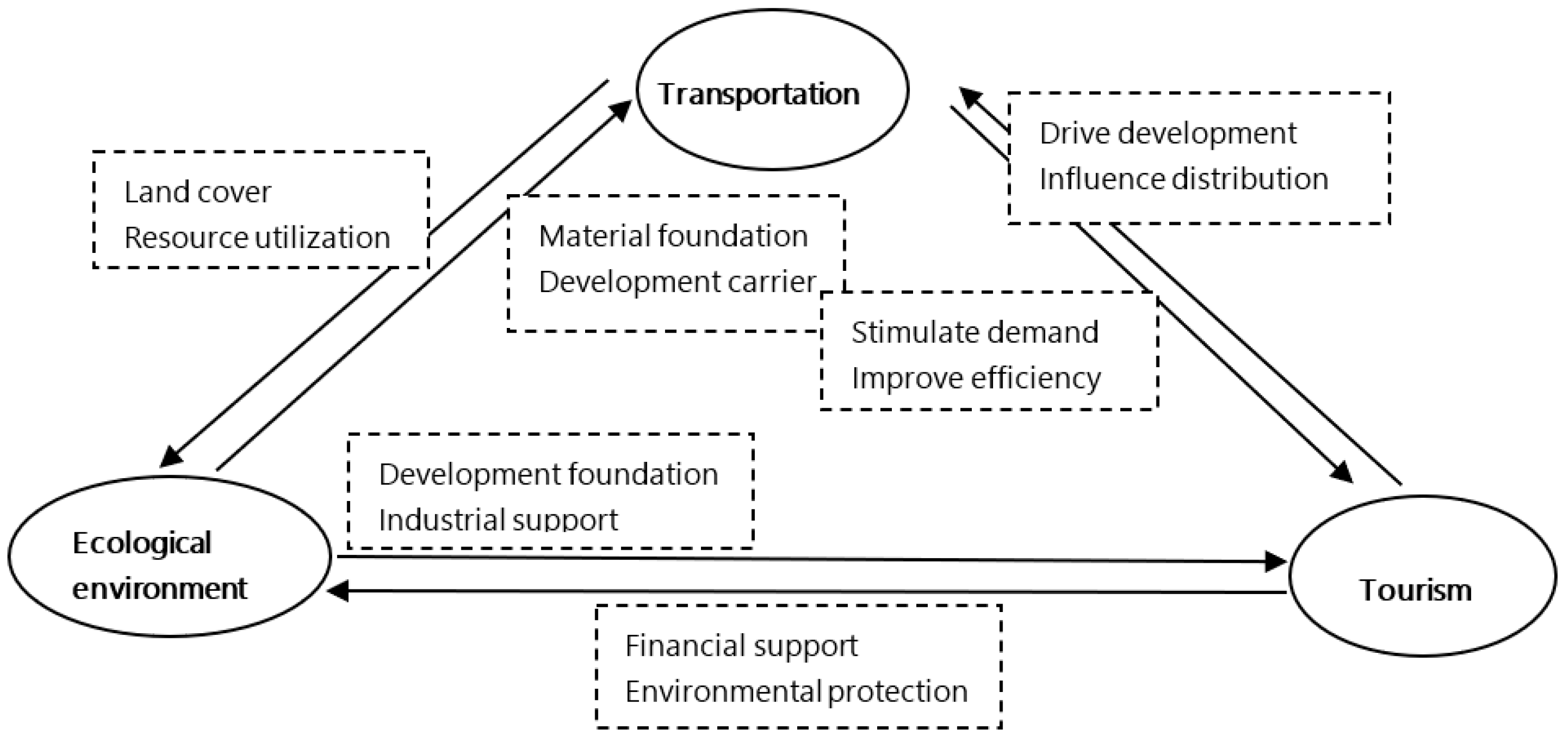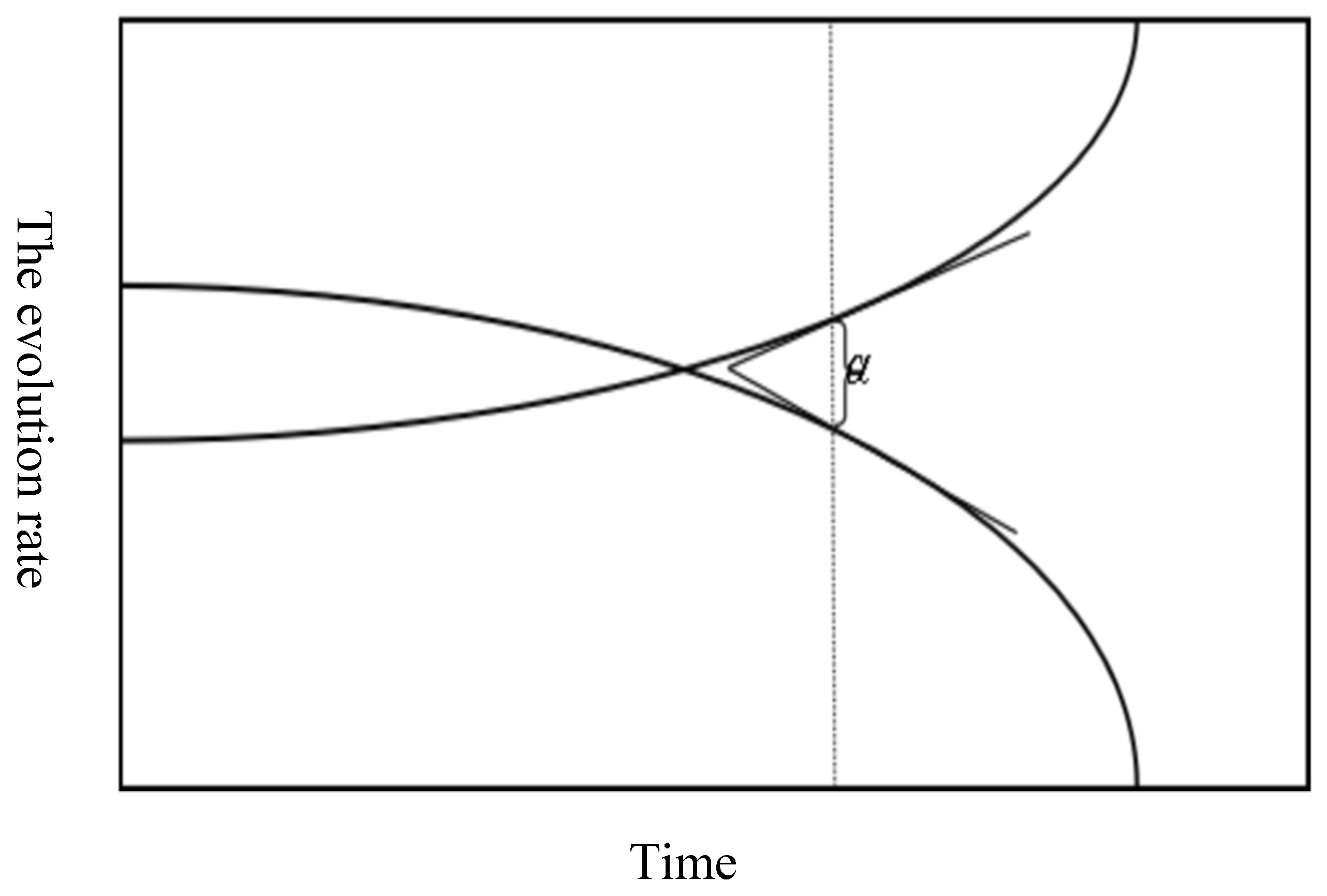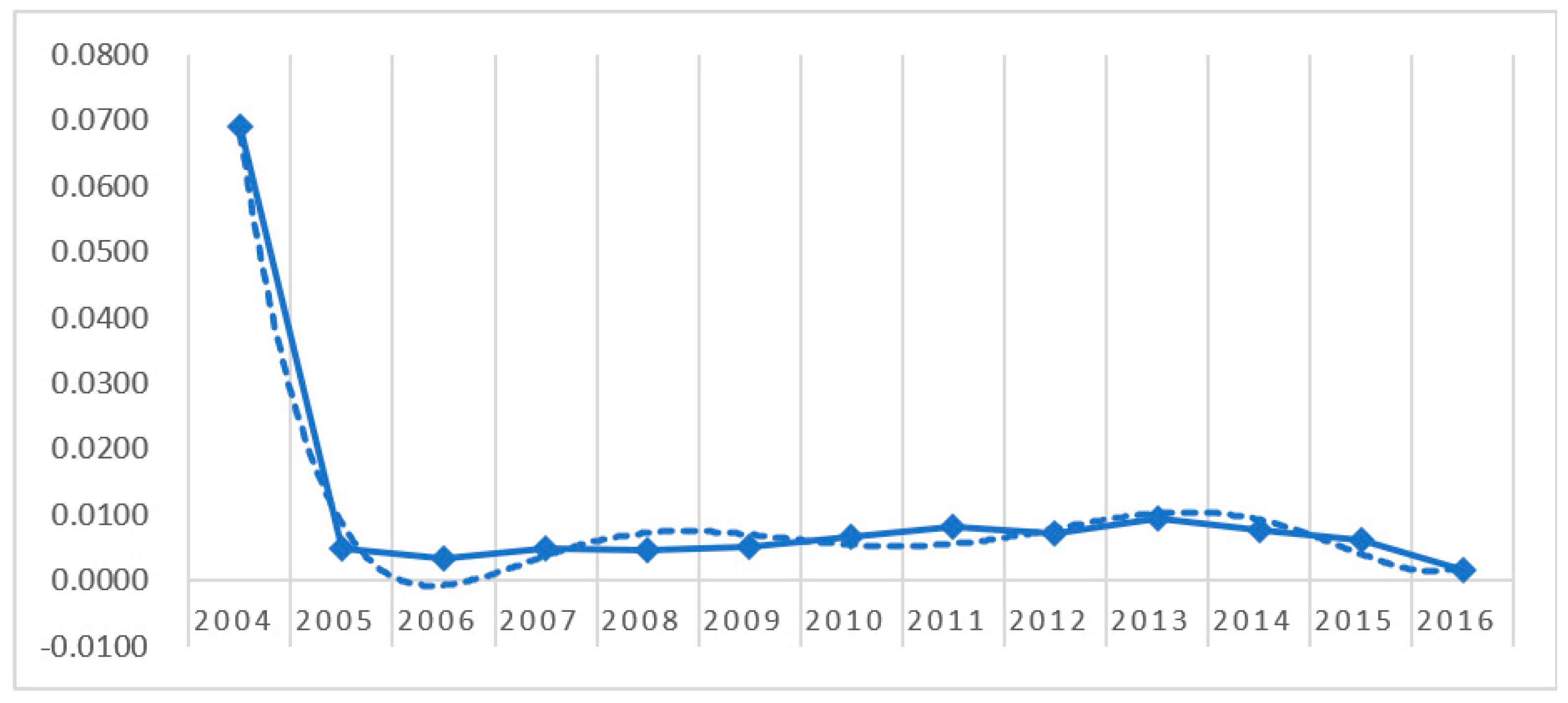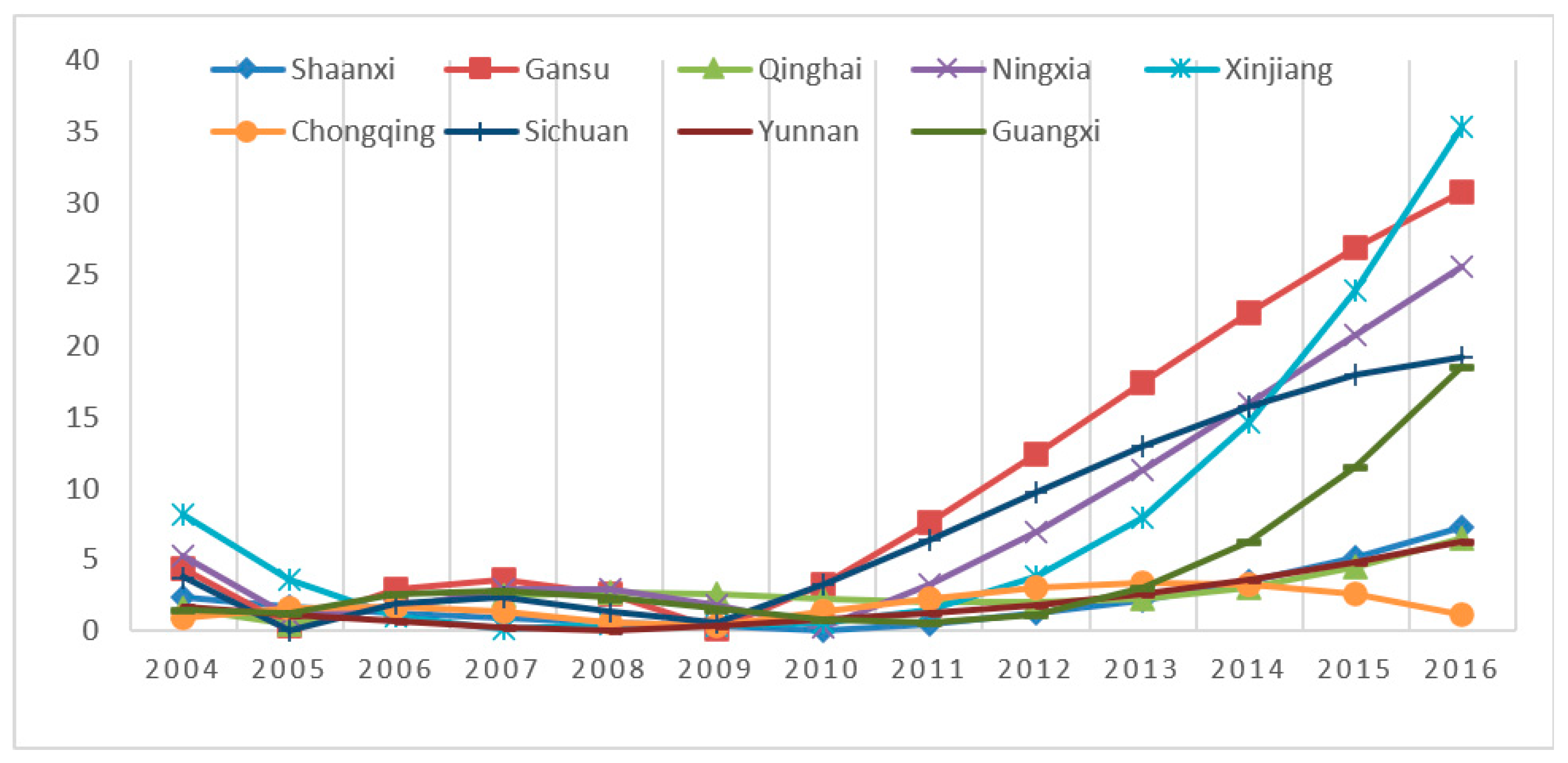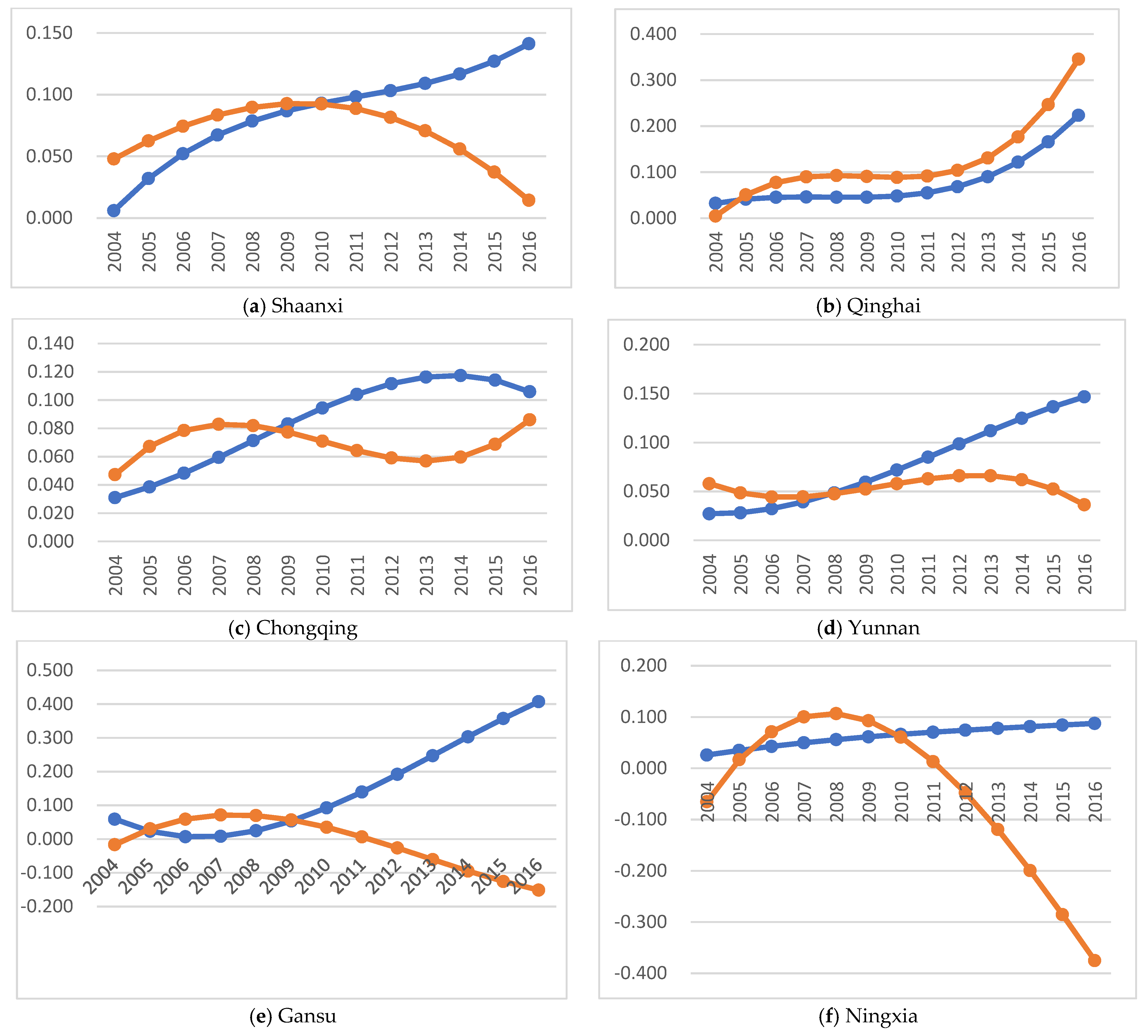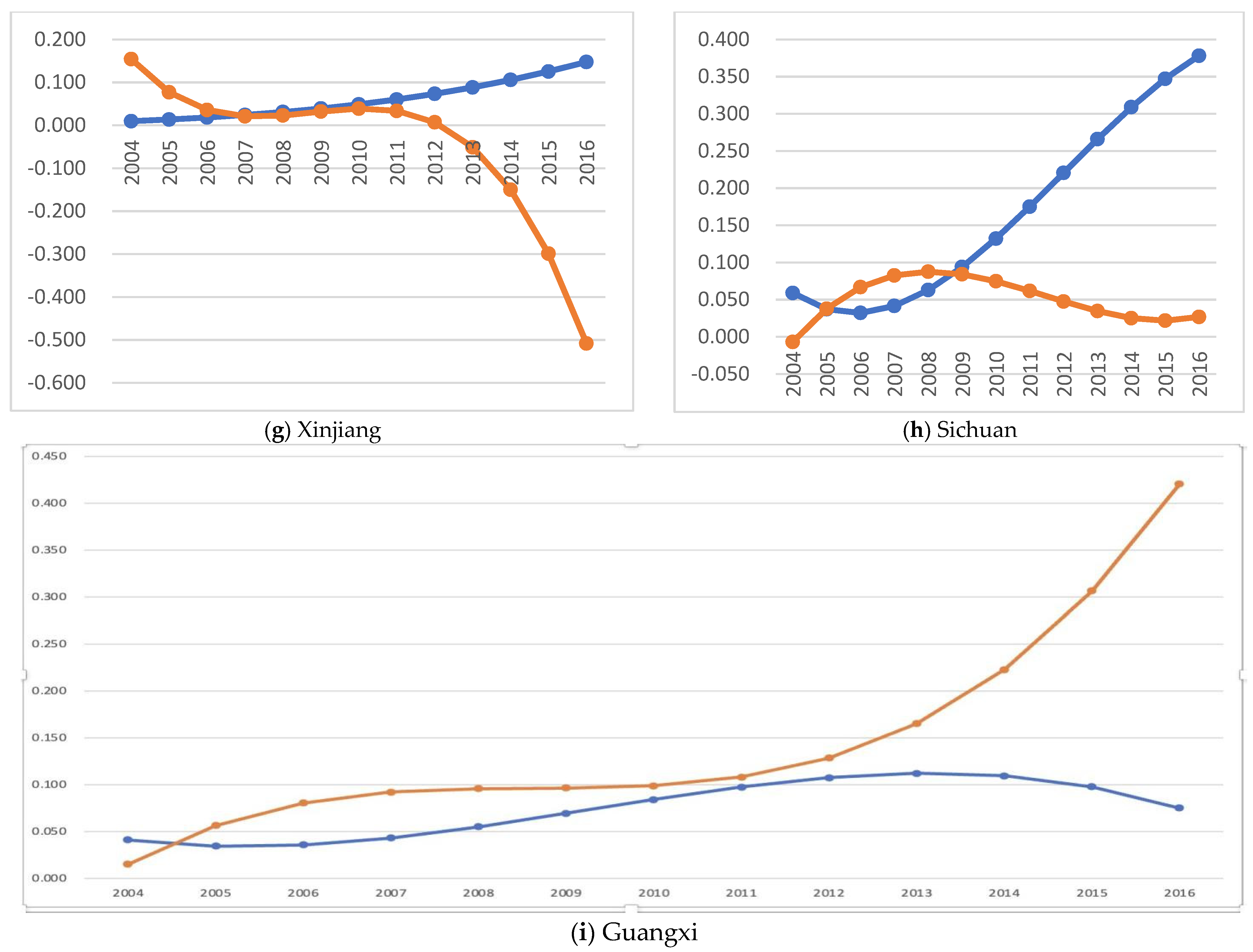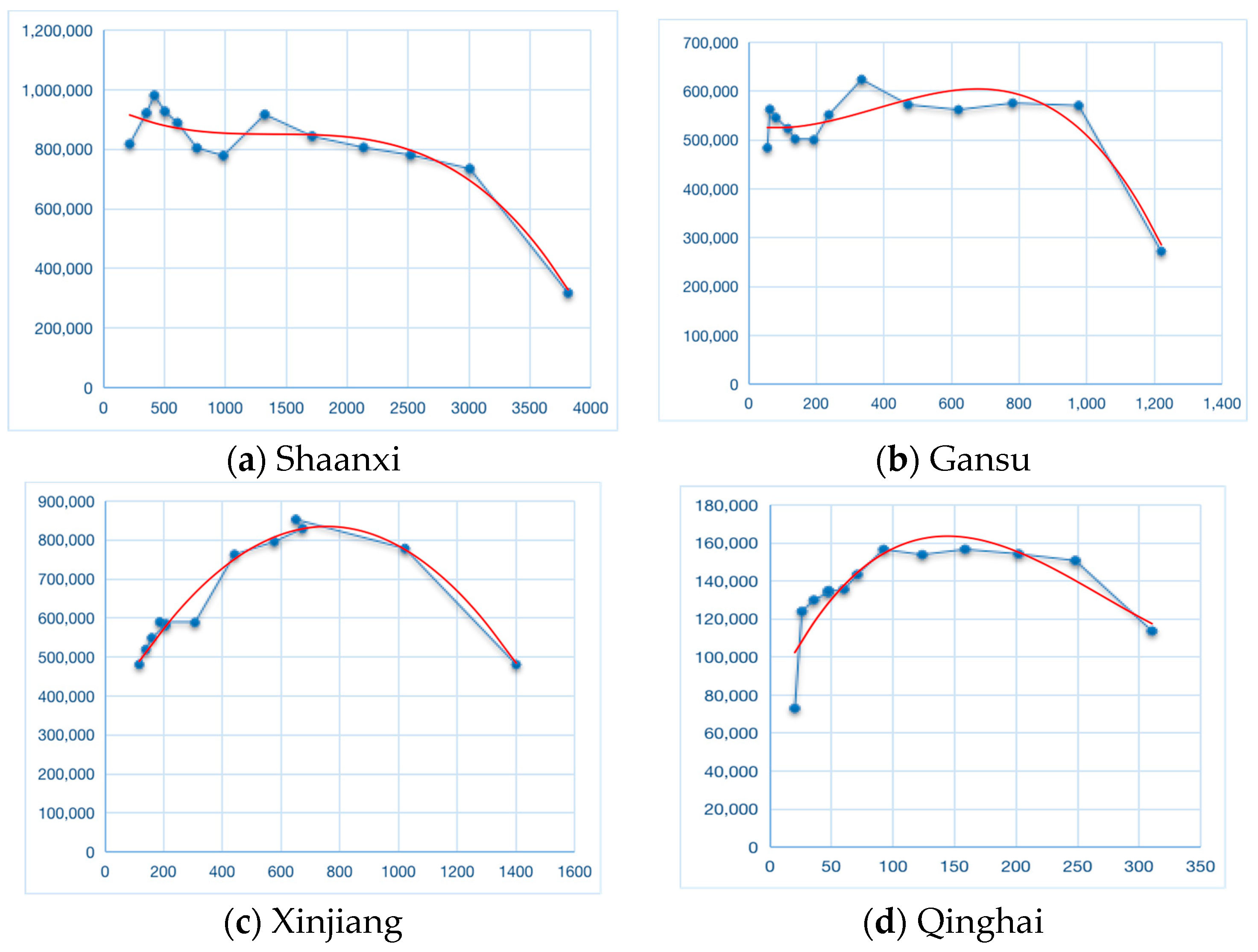1. Introduction
Building the Silk Road Economic Belt was a significant initiative, which was proposed by President Xi Jinping during his visit to Central and Southeast Asian countries in 2013. In order to promote the effective implementation of this strategy, China will cultivate new economic growth poles on the Silk Road Economic Belt by introducing industries and gathering the population. The implementation of the ‘One Belt, One Road’ initiative is conducive to the fast development of the provinces along the western route, and it creates rare opportunities for tourism development, cultural dissemination, and infrastructure construction in the central and western provinces. However, due to the current situation, the development of provinces along the Silk Road Economic Belt in China has the following problems: administrative barriers between provinces still exist, the radiation driving ability of central cities is insufficient, and the traffic accessibility between provincial capitals is inadequate; the ecological environment has relatively deteriorated, and the government is faced with the problems of carbon emission and watershed water pollution prevention and control. Regional industrial transfer and interest coordination mechanisms need to be improved, and barrier-free tourism zones still need to be implemented. Therefore, exploring the coupling and coordinated development of the tourism system, transportation system, and ecological environment system of provinces along the Silk Road Economic Belt is necessary to promote the integration process of these provinces, which is an important measure to boost the implementation of the western development strategy, and it is an important driving force to accelerate the west and central provinces to become the new supports of China’s economy.
Since entering the new century, the tourism industry has gradually become one of the most vigorous industries in the world’s economic activities. Among the many characteristics of tourism activities, the element characteristic of long distance determines that tourists need to use transportation to complete tourism activities. With the successful development of the tourism economy and the improvement of transportation networks, the relationship between the tourism economy and transportation development has gradually become a heated issue in academic research. However, the environmental dependence of tourism and the resource consumption of the transportation industry determine that there is a complex and unified relationship between the tourism economy, transportation development, and the ecological environment that restrict and promote each other.
The TTE system, which is a vast open system with complex content and a diversified structure, has the following coupling characteristics (The interaction relationship of the three subsystems in the TTE system is shown in
Figure 1).
Firstly, the ecological environment is an essential carrier on which the tourism and transportation industries carry out activities. On the one hand, the development of the tourism industry depends on the ecological environment. A good ecological environment can improve the experience and satisfaction of tourists and promote the sustainable and healthy development of the tourism economy. On the other hand, if the ecological environment is destroyed, the impact on traffic is undeniable. For example, natural disasters such as debris flow, sandstorms, and mountain landslides will reduce traffic safety and transportation efficiency, thus causing an increase in traffic operation costs.
Secondly, tourism development can guarantee the outcome of transportation and improve the ecological environment. Growth in tourism demand will stimulate the construction and expansion of transport infrastructure, and it can affect the evolution of transport network space–time patterns. In addition, the development of tourism should be based on not exceeding the carrying capacity of the local ecological environment. It can promote the improvement of the regional environment by providing funds and science and technology through the economic benefits generated by tourism.
Finally, the construction of transportation infrastructure effectively promotes the development of tourism and the protection of the ecological environment. Traffic can connect tourist sources and destinations, and regional traffic plays a crucial role in developing tourism economic activities. If transportation construction is blindly designed at the cost of the ecological environment, it will cause environmental problems such as vegetation degradation, species extinction, and resource waste.
At present, domestic and foreign scholars have studied the interaction between tourism and the ecological environment and tourism and transportation, and most of them focus on the perspective of binary relationships: the impact of tourism activities on the ecological environment, the coordinated development between transport and the tourism economy, and the effect of the ecological environment on tourism.
- (1)
Transportation, which is one of the three pillars of tourism, is a prerequisite for people to carry out tourism activities, the premise and material basis for tourism development, and the critical lifeblood of tourism development. In recent years, with traffic system upgrades, regions formed by highways, high-speed railways, civil aviation, and urban rail transits as the main body of the integrated operation of the system improve tourism between tourists and destination accessibility, shorten the residents’ travel time, and to some extent, deepen the correlation between the regional tourism industry; there are also new requirements for the spatial allocation of tourism resources. Jaarsma’s (2008) research on rural tourism found that traffic congestion has seriously affected the travel experience of leisure tourists. When formulating a traffic management plan, it is necessary to fully consider the area’s recreational uses and the interdependence of the actors involved [
1]. Houts et al. (2013) believes that although other tourist facilities have promoted the large-scale development of the tourism industry, the development of the air transportation industry has taken the tourism industry one giant step forward [
2]. Carolina et al. (2015) performed research in Brazil to study the interactive relationship between tourism and transportation, and they proposed new research methods [
3]. Alkheder et al. (2015) analyzed and evaluated the conditions of the existing transportation system of Ajloun, Jordan, and its contributions to the sustainable development of the country’s tourism industry, and they proposed that Jordan should fully consider its transportation industry planning when formulating tourism planning [
4]. Sharkhuu et al. (2020) argue that good infrastructure and excellent road network accessibility are crucial drivers of development in all sectors of the economy. The gravity model is used to conduct an empirical study on international tourists arriving in Mongolia. The influence of classic demand factors, such as transportation infrastructure and carbon dioxide emissions on Mongolian tourism flows, is expounded [
5]. Wang et al. (2021) evaluated tourism efficiency and transport accessibility from 2011 to 2017 by taking 17 administrative units in Hubei Province as research objects. The results show that the spatial matching and coupling degree between tourism efficiency and transport accessibility should be upgraded to improve the sustainability of tourism development [
6]. By comparing Bihor-Hajdú–Bihar and Maramures–Zakarpattya cross-border regions, Wendt et al. (2021) analyzed leading tourism indicators and studied the progress made in transportation infrastructure driven by tourism to determine whether there is a correlation between the development of transportation networks and the increase in tourist traffic [
7]. Papatheodorou’s (2021) research, based on microeconomics and economic geography tools, highlights the implications of air transport accessibility for tourism development. Utilizing synergy on synergies and revitalizing air transportation and tourism in the post-commercial environment of COVID-19 has added value, which is conducive to promoting the development of transportation and tourism [
8]. The interactive relationship between tourism and transportation in the paper is improved. Through the literature review of the transportation system and tourism system, it can be seen that current research on the interaction between the two systems has both qualitative and quantitative analysis, but the evaluation method is relatively singular, which will inevitably bring research limitations. In addition, there are few studies on the interactive relationship between the transportation system and tourism system in the Silk Road Economic Belt region. The research objects of this paper are the provinces and cities along the Silk Road Economic Belt in China, and the evaluation methods of the combination of entropy weight method and cosine theorem are adopted, so the conclusions have more reference value.
- (2)
Although tourism development can bring economic benefits to a region, it is crucial to consider the long-term impact of tourism on a particular area, especially on the premise that tourism depends on a specific ecological environment and the long-term effect of extensive development of tourism on the ecological environment. Hill et al. (2006) found that tourism activities interfere with the survival and reproduction of certain species on Mount Kosciuszko in Australia [
9]. Burgin et al. (2011) found that yachting activities in coastal waters will affect the physics, chemistry, and biology of the ocean ecosystem [
10]. Taking Harbin as an example, Xuan et al. (2013) created a mathematical model in 2010 to analyze the coordinated development relationship between Harbin’s tourism economy and the ecological environment, and they proposed policies and measures to promote the coordinated development of tourism and the ecological environment [
11]. Huang et al. (2013) believes that the increase in the number of tourists and the mismanagement of natural resources has caused severe damage to the ecological environment. Huang constructed an ecological security evaluation system for the scenic area of the island city in the Hunan Province and provided a model example for the sustainable development of island tourism [
12]. Gon et al. (2016) pointed out that the yacht tourism industry has resulted in negative environmental impacts, such as increased marine and coastal waste, increased sea pollution, and more crowded beaches on the Italian coastal cities of Grado and Lignan [
13]. Zhong et al. (2020) studied the reserve as a kind of recreation ecology and the relationship between the contradiction of ecological protection, analyzing the historical development process of recreation ecology tourism destinations in China, focusing on the impact of tourism on the natural environment, the environmental management of tourism, and the different types of sustainable tourism in the development of the tourism destination [
14]. Yong et al. (2021) collected data from 48 developing countries across Africa, Asia, and South America to determine the extent to which people’s awareness of environmental protection is at odds with ecological damage during tourism and to provide new insights into mitigating sea-level rise and promoting tourism [
15]. From the above literature review, it can be seen that the research results of scholars domestically and abroad on tourism systems and ecological environment protection are relatively affluent, but the research perspective still regards the tourism system and the ecological environment system as two separate systems to explain the impact of one system on another. The contribution of this paper to the existing literature is to build a TTE system including the transportation system, tourism system, and ecological environment system. It not only studies the interactive relationship between the ecological environment system and tourism system but also studies the role of the tourism system and ecological environment protection system in the coordinated development of a TTE system. In addition, the interaction between specific tourism system evaluation indicators and ecological environment protection indicators is also studied through the EKC model.
- (3)
It is important to conduct an interaction study of the transportation system and ecological environment system. Along with the development of transportation construction, the local ecosystem will be affected accordingly. There will be certain risks to water resources, land resources, forest resources, and other dependent aspects. Daigle et al. (2010) analyzed the impact of unpaved roads in Colombia on land, vegetation, and wildlife and argued that proper planning should be adopted to reduce the negative effect of paved roads [
16]. Zhou et al. (2011) took the integrated transportation system and the ecological environment system as the research objects and analyzed the interactive relationship between the integrated transportation system and the ecological environment system by using the game model and analyzing the factors that affect the sustainable development of integrated transportation [
17]. Zhou et al. (2012) believed that with the emergence of new transportation concepts and the development of advanced transportation methods, the construction of comprehensive transportation must meet the principles of ecology planning, reduce resource and energy consumption, reduce environmental pollution, and promote the harmonious development of the transportation industry and the environment [
18]. Sun et al. (2015) believes that carbon dioxide emissions are the leading cause of global warming. The implementation of environmentally friendly regional transportation is essential to promote the sustainability of the tourism industry. Based on this idea, a model for estimating carbon dioxide emissions from regional tourism transportation was constructed and erected [
19]. Ma et al. (2008) analyzed the interaction between energy consumption and environmental pollution in transport and discussed the social and economic benefits of energy conservation and emission reduction [
20]. Wang et al. (2019) studied the positive impact of transportation activities such as tourist roads on ecology, entertainment, culture, and education while bringing tourism value to scenic spots [
21]. Li et al. (2020) point out that a range of transport policies are used in both developed and developing countries to seek ways to mitigate pollution, showing that transport policies have significant and lasting impacts on urban life and global climate change [
22]. Through the literature review of the transportation system and ecological environment protection, it can be seen that the current research mainly expounds on the relationship between the transportation facilities’ construction and ecological environment protection through qualitative methods. The contribution of this paper to the existing literature is to establish a comprehensive evaluation index system of the transportation system and ecosystem and quantitatively study the interactive relationship between the provinces and cities along the Silk Road Economic Belt from 2004 to 2016 by using a variety of methods. By analyzing the critical evaluation indexes, we can find a way to improve the benign interaction between the transportation system and ecological environment protection.
- (4)
As a brief literature summary, domestic and foreign scholars who study the tourism system, the transport system, and the ecological environment system in a single system or a dual system in this field of research enrich the theory of this paper and provide valuable references. Nevertheless, the evaluation index selection lacks consideration, and the evaluation system is a little rough and straightforward, which cannot accurately and reasonably reflect the development of the TTE system. In the determination of index weight, a single subjective weight method or single objective weight method makes the weight have an inevitable defect. Most of the research on coordination evaluation is limited to static coordination assessment degree, and few studies use the scissors difference model to further analyze its dynamic evolution characteristics. In related studies, few scholars use the mean square error index model to study the spatiotemporal characteristics of coupling coordination degree.
This paper establishes a comprehensive evaluation index system of the TTE system. The objective weight of each evaluation index under different methods is determined by the law of cosine and entropy weight. The comprehensive weight of each evaluation index is determined by the combination weighting method of game theory. Based on this, the comprehensive evaluation value of each sample is calculated; this value is used to judge the pros and cons of the evaluation object. Second, the coupling coordination degree model and the scissors model are used to dynamically analyze the time evolution of the coupling coordination degree among the tourism system, the transportation system, and the ecological environment system of the nine provinces along the Silk Road Economic Belt from 2004 to 2016. Then, the provinces are divided by the coupling coordination degree to analyze interprovincial and north–south differences. Finally, using the interactive relationship between the tourism system and transportation system, tourism economic development and environmental quality are analyzed using the scissors model and the Kuznets curve. The analysis results provide a valuable and scientific basis for the relevant entities to formulate coordinated development strategies. It can be seen that to a certain extent, the research in this paper makes up for the gap in previous studies.
Compared with the existing literature, the possible innovations of this paper are as follows:
- (1)
Most scholars use a single system or double system to measure the coupling degree and coupling coordination degree. In this paper, based on the current research results of coupling coordination and the actual development of nine provinces along the Silk Road Economic Belt, an evaluation index system of coupling coordination degree of the TTE system consisting of three subsystems is established.
- (2)
This paper uses the method of entropy weight, the law of cosines, the combination weighting method in game theory, the coupling coordination degree model, and the scissors model along with the Silk Road Economic Belt province of the TTE system coupling and coupling coordination degree of measurement. Through the mean square deviation index model, this paper delves into nine provinces using the coupling coordination degree of regional differences and north–south differences. The results show the temporal and spatial characteristics of coupling coordination degree, and they show its temporal variation and spatial evolution more directly.
- (3)
This paper not only confirms the rising trend of the coupling coordination degree of the TTE system in the Silk Road Economic Belt and the unbalanced spatial pattern of its distribution but also further explores the interactive relationship between tourism, economic development, and the ecological environment by using the EKC model.
Theoretical significance:
- (1)
Having perfected the subsystems of travel, the transportation subsystem, and the ecological index evaluation system simultaneously to overcome the defects of the single evaluation method, this paper uses the method of cosine theorem and the entropy weight method to determine the objective weight of each evaluation index. Each index was determined by the method of game theory combination empowerment of combination weight, making the three subsystems of comprehensive evaluation more accurate.
- (2)
The coupling coordination degree of each subsystem is elaborated, and the theoretical framework of the TTE system is perfected. Before the study of an area along with the province, primary consideration for a single subsystem (traffic system, tourism system, and ecosystem) or of the interactions between two subsystems will expand the research to three systems; this paper established the TTE integration system, which is a comprehensive study of the complex coupling relationship between the three subsystems.
Practical significance:
- (1)
The construction of the ‘Belt and Road’ initiative is an important measure to expand China’s all-around opening up under the new situation, which is conducive to more countries sharing development opportunities and achievements. The development of tourism, transportation, construction, and the improvement of the environment to promote the implementation of the area play an important role. Still, there are inevitable provinces along the Silk Road Economic Belt with weak infrastructure, destroyed ecological environment, and stumbling problems in tourism development; because of this study, promoting the coordinated development of the TTE system and measures has practical significance.
- (2)
The implementation of the economic development strategy along the Belt and Road provides a relatively loose external environment and good opportunities for the old industrial base of northeast China. The conclusions of this study also have specific guiding significance for the revitalization of the old northeast industrial base.
The sections of this study are arranged as follows: the first section is the introduction and related literature review; the second section introduces the materials and methods of this study and describes the research area, evaluation index system, data sources, and data preprocessing; the third section discusses the results and related explanations; the fourth section presents the research conclusions and policy recommendations.
2. Materials and Methods
2.1. Study Area
At the end of 2017, the nine provinces along the Silk Road Economic Belt accounted for 16.92% of China’s total economic output. These nine provinces have rich natural and cultural resources, allowing their tourism industries to grow significantly. Among them, Shaanxi, Sichuan, Yunnan, Guangxi, and Xinjiang have huge tourism industries with abundant tourism resources, and they are in leading positions in national tourism development compared to the other provinces. Strong economic growth and reliable transportation networks can enable tourism development in Chongqing, Gansu, Qinghai, and Ningxia to maximize their significant late-comer advantages and huge development potential. In addition, transportation in these provinces has developed rapidly, and the operating mileage of various modes of transportation and the turnover of tourism have been increasing. In 2014, President Xi Jinping proposed that the Silk Road Economic Belt should realize the “five links” of policy, currency, roads, trade, and people’s hearts. Road connectivity is the key to realizing these five links. Countries and domestic provinces along the route have actively responded to the One Belt, One Road initiative and have increased the construction of transportation infrastructure. However, the development of the nine provinces along the route is not without its challenges, as the ecology outlook is not optimistic. According to the China Environmental Statistics Yearbook, in 2017, the wastewater discharge of the nine provinces along the route was 13.46 billion tons. Furthermore, the early tourism development and transportation infrastructure construction occurred too quickly at a large scale and without consideration for protecting the ecological environment. Serious problems, such as environmental pollution, environmental degradation, and resource depletion, have gradually become prominent.
2.2. Evaluation Index System and Data Sources
For the setting of indicators, scholars have different views. Shu et al. (2015) evaluated the tourism system with four grade 1 indicators, including tourism effect, tourism income, tourism employment, and tourism industry, and 10 grade 2 indicators. The evaluation indexes of an ecosystem include the population index, economic index, social index, cultural index, and ecological environment index, which are 5 grade 1 indexes and 27 grade 2 indexes [
23]. Fei et al. (2021) built the evaluation indexes for the economic system, including the economic development scale and social and economic construction; evaluation indexes for the ecosystem include environmental pollution status and effectiveness of environmental management, and evaluation indexes for the tourism system include tourism market size and tourism factor structure [
24]. Han et al. (2021) evaluated the economic systems, including economic aggregate, economic benefits, and economic structure, and they assessed the environmental systems, including environmental quality and environmental governance [
25]. Tang et al. (2015) evaluated the tourism system by developing scale and economic benefits, and they assessed the ecosystem by ecological quality, resource consumption, and environmental protection [
26]. Wu et al. (2019) evaluated the transportation system, including infrastructure construction, transportation service, and transportation efficiency. They evaluated the tourism system including tourism industry scale, tourism industry benefit, and tourism service [
27].
Based on the availability of data, the representativeness of indicators, the comprehensiveness of evaluation, and the existing research, this paper closely focuses on six dimensions, including scale, conditions, scale efficiency, status, pressure, and response, and it selects 27 evaluation indicators to construct an evaluation index of the TTE system (
Table 1).
The data are sourced from the China Statistical Yearbook, the China Environment Statistical Yearbook, the China Tourism Statistical Yearbook, and the China City Statistical Yearbook, as well as other statistical yearbooks and national economic and social development statistical bulletins from 2004 to 2016.
2.3. Research Methods
2.3.1. Determination of Comprehensive Weight
Most prior studies adopt a single method to determine the weight of the evaluation index, which cannot overcome the shortcomings of using a single evaluation method. Therefore, this paper adopts the law of cosines and the entropy weighting method to determine the weight of each evaluation index; then, it calculates the comprehensive weight of each evaluation index through the combination weighting method of game theory.
The Law of Cosines
The cosine-included angle value, also known as the similarity, can objectively display the deviation degree of the distribution of each index value to better reflect the relative importance of each index. The specific steps are as follows (Xu et al., 2017) [
28].
- (1)
Construct the optimal solution vector
and the worst solution vector
of the evaluation index
where
and
represent the best value and worst value of each evaluation index, respectively;
represents the index evaluation value of the
index in year
;
and
represent the positive effect index set (benefit index set) and the negative effect index set (cost index set), respectively; and
represents the number of index evaluations.
- (2)
Use the range method to establish the relative deviation matrix between each evaluation plan and the optimal solution vector and the worst solution vector:
where
represents the relative deviation matrix between each evaluation plan and the optimal solution vector;
represents the relative deviation matrix of each evaluation plan and the worst solution vector;
represents the degree of deviation between
and the absolute value of the optimal value
relative to the range; and
represents the degree of deviation between
and the absolute value of the worst value
relative to the range.
- (3)
Determine the cosine-included angle value of the index:
where
represents the cosine-included angle value between the optimal deviation matrix row vector
and the worst deviation matrix row vector
, which reflect the influence of the deviation between the evaluation object and optimal solution vector and the worst solution vector on the weight of the evaluation object, respectively.
- (4)
Normalize the cosine-included angle value of each index:
where
represents the normalized cosine-included angle value (i.e., the cosine included angle weight) and
represents the number of indicators.
The results of the law of cosine calculations are shown in
Appendix A.
Entropy Weighting Method
The entropy weighting method is a standard objective weighting method that was first proposed by Shannon in 1948 to reflect the degree of disorder of information in the entropy value (Shannon, 1948) [
29]. The larger the index entropy value is, the greater the effect of the index on decision making.
As a result of the difference, or positive and negative directions of the magnitude and dimension of each data point, it is necessary to normalize and standardize the original data and then calculate the index entropy weight.
The entropy weighting method is widely used in research. Zhang et al. (2014) selected eight typical pollutants as evaluation factors and determined the weight of water quality evaluation indicators based on the entropy weighting method [
30]. Wang et al. (2020) evaluated the characteristics of 227 selected coal-fired power plants in China from 2012 to 2014 by using the entropy weighting method. They analyzed the coupling relationships among water, energy, and emissions [
31].
- (1)
The unquantified data processing is as follows:
Negative indicators:
where
denotes the value of the indicator
in year
and
and
indicate the maximum and minimum values of indicator
for all years, respectively. Thus, all the index values are in the range of (0,1).
- (2)
For the specific calculations using the entropy weighting method, refer to the literature (Yan et al.,2014 [
32]; Jesmin et al., 2014 [
33]) and
Appendix B.
Game Theory Comprehensive Weighting Method
The game theory combination weighting method is a new combination weighting method that has been proposed in recent years. For the calculation process, refer to the literature (Lai et al., 2015 [
34]; Zhao et al., 2017 [
35]), and for the calculation results, refer to
Appendix C. Wang et al. (2019) combined the two objective weighting methods with game theory to determine comprehensive weighting, evaluated the sustainability of China’s shale gas industry, and concluded that the overall sustainable development level of China’s shale gas industry is low [
36]. Based on the combination weighting method of game theory, Zhu et al. (2021) integrated the three indicators to evaluate the importance of transmission lines into a comprehensive index for evaluating critical transmission lines in the power system [
37].
The calculation formula is as follows.
Firstly, obtain
n weights according to n types of weighting methods; then, construct a basic weight vector set
. A possible weight set is combined by
vectors with the form of arbitrary linear combination as:
where
u is a possible weight vector in set
and
is the weight coefficient. Remarkably, in this paper,
is equal to two (i.e., the law of cosines and IEW). Then, determine the most satisfactory weight vector
of the possible weight vector sets according to the concept of game theory, suggesting that a compromise was reached among
weights. Such a compromise can be regarded as optimization of the weight coefficient
, which is a linear combination. The optimization aims to minimize the deviation between
and
to use the following formula:
According to the differentiation property of the matrix, the condition of optimal first-order derivative is:
The corresponding system of the linear equations is:
Step (3): Calculate the weight coefficient (α1, α2 · · · αn) and then normalize it with the following formula:
Lastly, the combined weight will be obtained as:
2.3.2. Comprehensive Development Level Evaluation Model
The combination weight and standardized value of the evaluation index are determined based on the law of cosines, the entropy weighting method, and the game theory comprehensive weighting method.
Calculate the comprehensive development level of each of the three subsystems by combining weights and standardized values. The formula is as follows:
where
,
, and
represent the comprehensive development level of the tourism subsystem, transportation subsystem, and ecological environment subsystem, respectively.
,
, and
represent the unquantified values of the tourism subsystem, transportation subsystem, and ecological environment subsystem, respectively.
represents the index combination weight,
indicates the province (of which there are 9),
represents the year (of which there are 13 years from 2004 to 2016), and
represents the evaluation indicators of each system (of which there are 9).
2.3.3. Coupling Coordination Degree Model
The coupling coordination degree indicates the comprehensive value of two or more systems interacting based on various interactions. Zuo et al. (2021) used the coupling coordination degree model to measure the relationship between the ecological environment and economy and society and nature [
38]. Similarly, Liu et al. (2021) used the coupling coordination degree model to evaluate the coordination level between carbon and air quality mitigation in 34 pilot low-carbon cities in China. They found that most pilot cities showed moderate coupling coordination between low-carbon development and air quality [
39].
The development of the tourism industry, the construction of the transportation infrastructure, and the evolution of the ecological environment are intertwined in an interactive and dynamic relationship. The degree of coupling is a quantitative representation of the degree of interaction between systems. The model is as follows (Wang et al., 2017) [
40]:
where
is the coupling degree of the three systems. The larger the value of
is, the stronger the interaction between the systems. When
, there is no correlation between the systems, and the system develops into disorder.
,
, and
represent the comprehensive evaluation value of each subsystem of the tourism industry, the transportation industry, and the ecological environment, respectively.
This paper introduces the coupling coordination degree model to reflect the coupling degree and coordination level in the interaction process of each subsystem. The formula is as follows:
represents the comprehensive coordination index of the tourism system, transportation system, and ecological environment system and reflects the overall synergy of the three subsystems;
represents the degree of coupling and coordination of the entire system (The classification standard of coupling coordination degree is shown in
Table 2); and
,
, and
represent undetermined coefficients. The development of the tourism industry is one factor that can promote the growth of the transportation industry to a certain extent, although it is not the only factor. The development of the tourism industry, and the activities of tourists, are only one of the factors that impact the ecological environment. Based on the existing literature, this article argues that the three systems are equally important, so the values of
,
, and
are all set to one-third.
2.3.4. The Mean Square Error Index Model
The northern and southern regions constitute China’s Silk Road Economic Belt. To explore the regional differences in the coupling coordination degree between various provinces and cities, the total difference in the coupling coordination degree is divided into interregional and interprovincial differences. The formula is (Zhang et al., 2018) [
41]:
where
represents the overall mean square error;
and
represent the regional mean square error and interprovincial mean square error, respectively;
represents the average value of the coupling coordination degree of each province;
is the coupling coordination degree of each province;
in region
;
represents the number of provinces in the economic zone;
is the mean value of the coupling coordination degree of each province in the region
;
represents the number of regions; and
represents the number of provinces contained in region
.
2.3.5. Scissor Difference Model
Seton et al. (2000) first proposed the concept of the scissors difference to describe the trend of the price gap between industrial products and agricultural products [
42]. The scissors difference is now widely used in economic research (Yue et al., 2006) [
43]. Liu et al. (2020) established a scissors difference model to study the dynamic evolution mechanism of the socioeconomic water environment system. They concluded that the speed difference between the two subsystems showed a downward trend, and the scissors difference was effectively controlled [
44]. Su et al. (2021) constructed an evaluation index system and used the scissors difference method to study the ecological environment and social and economic development of Ningxia. The results showed that the scissors difference decreased first and then increased in a U-shaped trend, indicating that the development difference between the two systems decreased first and then increased [
45].
In this paper, we use the scissors difference model to measure the difference in development trends between the sea system and the land system at a given point in time. The larger the scissors difference is, the more significant the difference between the development trends of the two systems (see
Figure 2).
The specific calculation process of the scissors difference model is as follows.
Scissors difference model: Suppose the two research systems are x and y. Obtain the coupling equations of the system
and the system
by fitting all the comprehensive evaluation values of system
and system
in EXCEL. Then, calculate the tangent angle
α between
and
at a given time. The greater the value of
α, the more significant the difference between the
x system and
y system will be. The specific calculation formula is as follows:
where the range of
t is 1 to 13, corresponding to the years 2004–2016.
2.3.6. Environment Kuznets Curve
Since the 1990s, many research methods have been developed to study the relationship between environmental pollution and economic growth, the most representative of which is the environmental Kuznets curve (EKC), a hypothesis that was proposed by Genegrossman and Kruemeger in 1995. Its core view is that when a country’s economic development level is low, the degree of environmental pollution is low. However, as the economy continues to develop and the per capita income rises, the degree of environmental pollution also continues to increase. However, when the economy grows to a certain level (i.e., after reaching a critical point or an inflection point), environmental pollution will start to decrease. With the continuous development of the economy, ecological quality is improved. The process of ecological decay changes throughout economic growth and exhibits an inverted U-shaped curve, which is called the EKC (Grossman et al., 1994 [
46]). The EKC has been observed in some developed countries. Still, some scholars have pointed out that depending on time and regional factors, it does not necessarily have an inverted U-shaped curve but may also have a U-shaped, N-shaped, or cubic curve (Yang et al., 2017 [
47]; Ran et al., 2018 [
48]).
In domestic and foreign literature, the environmental Kuznets curve is widely used to study the relationship between environmental pollution and economic growth. Yang et al. (2021) conducted a quantitative linear regression analysis of economic growth and environmental pollution in the region based on the Kuznets curve, and they verified the particularity of the Kuznets curve [
49]. Li et al. (2021) studied the relationship between environment and economy in 89 Belt and Road countries from 1995 to 2017 and tested the environmental Kuznets curve. The research shows an inverse U-shaped relationship between environmental degradation and economic growth [
50]. Cui et al. (2019) summarized the inverted U-shaped environmental Kuznets curve of dynamic evolution from the perspective of an economic development level and development structure based on the traditional Kuznets curve [
51].
In recent years, the application scope of the environmental Kuznets curve has been expanding, and more and more scholars have applied it to study the relationship between tourism and ecology. Sun et al. (2021) discussed the relationship between tourism and ecological innovation from 1995 to 2018 under the framework of the environmental Kuznets curve (EKC) [
19]. Similarly, Tian et al. (2020) studied the relationship between tourism and environment by using the environmental Kuznets curve, and the research results show that tourism development is the driving force to reduce carbon dioxide emissions [
52].
The tourism industry, as a significant pillar of the national economy, has caused severe environmental degradation. In this paper, we construct an EKC model between total tourism revenue, which is used as an evaluation index of the economic level of tourism, and the ecological environment, which is measured by sulfur dioxide emissions, total wastewater discharge, and industrial solid waste generation indicators, to explore the interactive relationship between tourism development and the ecological environment in nine Chinese provinces.
We used SPSS mathematical statistics software to fit the model curve, compare the degree of fit, and determine the EKC of the tourism economic level and the ecological environment level. The basic model is as follows:
where
represents the environmental pollution suffered at time
; the indicator variables are sulfur dioxide emissions, total wastewater emissions, and industrial solid waste generation;
represents the total tourism revenue at time
;
,
, and
are parameters to be estimated; and
is a constant term.
Depending on the value of
, the shape of the EKC can be classified into the following types, as shown in
Table 3.
